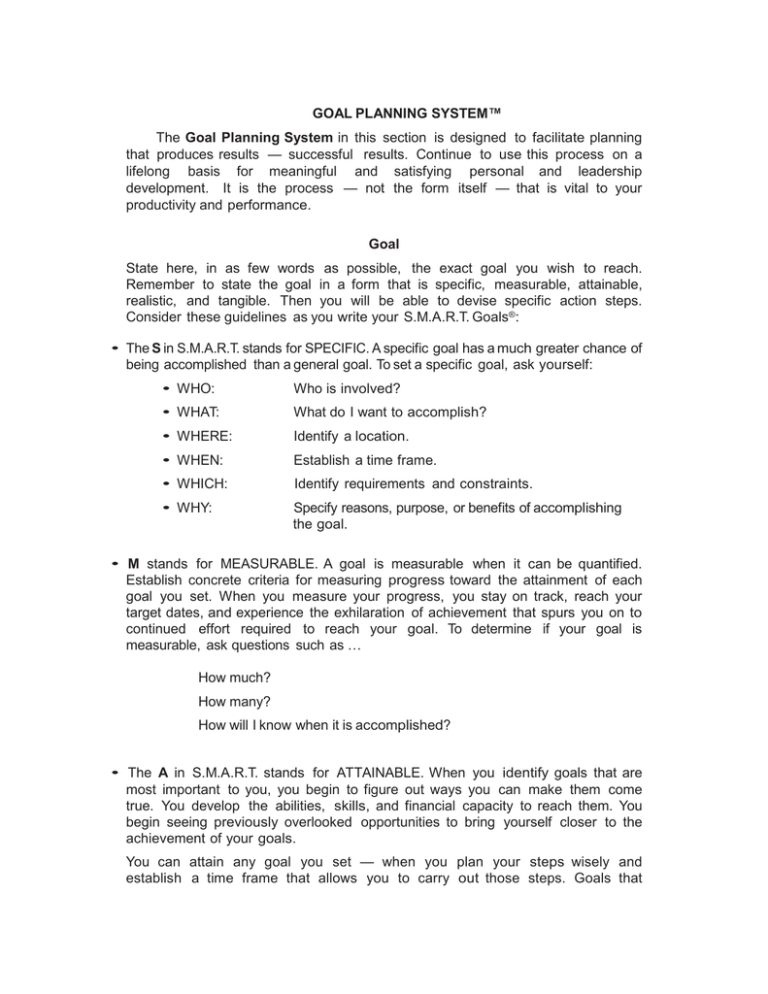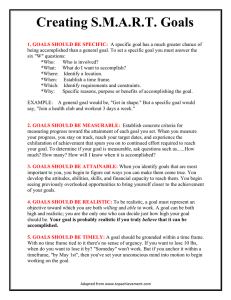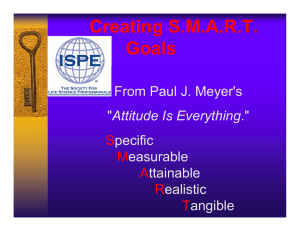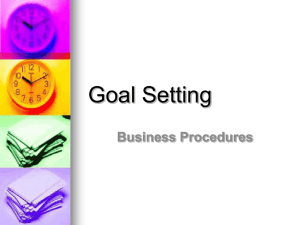
GOAL PLANNING SYSTEM™
The Goal Planning System in this section is designed to facilitate planning
that produces results — successful results. Continue to use this process on a
lifelong basis for meaningful and satisfying personal and leadership
development. It is the process — not the form itself — that is vital to your
productivity and performance.
Goal
State here, in as few words as possible, the exact goal you wish to reach.
Remember to state the goal in a form that is specific, measurable, attainable,
realistic, and tangible. Then you will be able to devise specific action steps.
Consider these guidelines as you write your S.M.A.R.T. Goals®:
• The S in S.M.A.R.T. stands for SPECIFIC. A specific goal has a much greater chance of
being accomplished than a general goal. To set a specific goal, ask yourself:
• WHO:
Who is involved?
• WHAT:
What do I want to accomplish?
• WHERE:
Identify a location.
• WHEN:
Establish a time frame.
• WHICH:
Identify requirements and constraints.
• WHY:
Specify reasons, purpose, or benefits of accomplishing
the goal.
• M stands for MEASURABLE. A goal is measurable when it can be quantified.
Establish concrete criteria for measuring progress toward the attainment of each
goal you set. When you measure your progress, you stay on track, reach your
target dates, and experience the exhilaration of achievement that spurs you on to
continued effort required to reach your goal. To determine if your goal is
measurable, ask questions such as …
How much?
How many?
How will I know when it is accomplished?
• The A in S.M.A.R.T. stands for ATTAINABLE. When you identify goals that are
most important to you, you begin to figure out ways you can make them come
true. You develop the abilities, skills, and financial capacity to reach them. You
begin seeing previously overlooked opportunities to bring yourself closer to the
achievement of your goals.
You can attain any goal you set — when you plan your steps wisely and
establish a time frame that allows you to carry out those steps. Goals that
may have seemed far away and out of reach eventually move closer
become attainable- not be-cause your goals shrink, but because you grow
expand to match them. When you list your goals, you build your self-image.
see yourself as worthy of these goals and develop the traits and personality
allow you to possess them.
and
and
You
that
• The R in S.M.A.R.T. stands for REALISTIC. To be realistic, a goal must represent
an objective toward which you are both willing and able to work. A goal can be
both high and realistic; you are the only one who can decide just how high your
goal should be. But be sure that every goal represents substantial progress. A
high goal is frequently easier to reach than a low one because a low goal exerts
low motivational force. Some of the hardest jobs you ever accomplished actually
seemed easy simply because they were a labor of love.
Your goal is probably realistic if you truly believe that it can be accomplished.
Additional ways to know if your goal is realistic is to determine if you have
accomplished anything similar in the past or ask yourself what conditions would
have to exist to accomplish this goal.
• The T in S.M.A.R.T. stands for TANGIBLE. A goal is tangible when you can
experience it with one of the senses — that is, taste, touch, smell, sight, or
hearing. When your goal is tangible, or when you tie an intangible goal to a
tangible goal, you have a better chance of making it specific and measurable
and thus attainable.
Intangible goals are your goals for the internal changes required to reach more
tangible goals. They are the personality characteristics and the behavior patterns
you must develop to pave the way to success in your career or for reaching some
other long-term goal. Since intangible goals are vital for improving your
effectiveness, give close attention to tangible ways of measuring them.
Used with permission from The Meyer Resource Group,® Inc. Copyright © The Meyer
Resource Group,® Inc. ALL RIGHTS RESERVED
SAMPLE
GENERAL VS. SMART GOALS
GENERAL
SPECIFIC
“Get organized.”
“Schedule
minutes
daily for uninterrupted
planning and goal setting.”
“Get in shape.”
“Join a health club and work
out 3 times a week.”
“Earn more money.”
“Seek
percent
raise by
(date)
through obtaining new
responsibilities.”
“Have a quality
family life.”
“Spend increased time of 30
minutes a week just to listen
and talk with
(spouse, child, other family
member).”
“Learn about music.”
“Purchase season tickets
to attend all the symphony
concerts this year.”
“Improve my health.”
“Maintain my ideal weight of
and lower my
cholesterol to under 200 by
(date).”
“Establish a deeper
spiritual/ethical identity
for myself.”
“Schedule a monthly lunch
appointment with a positive
role model or mentor.”
“Increase business
knowledge.”
“Read one best-selling
business book this month
that applies to a project/
process I am currently
working on.



